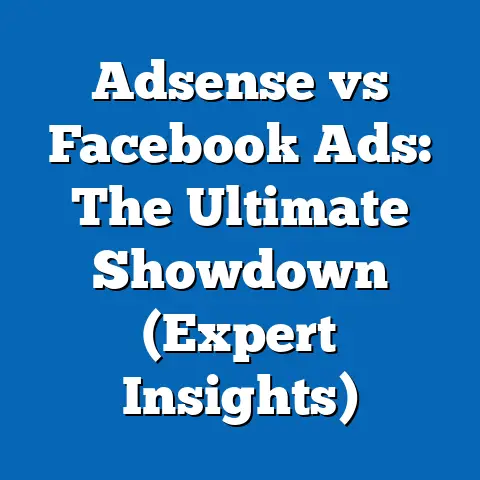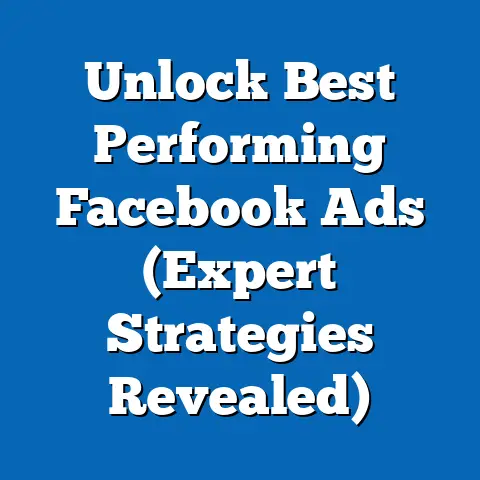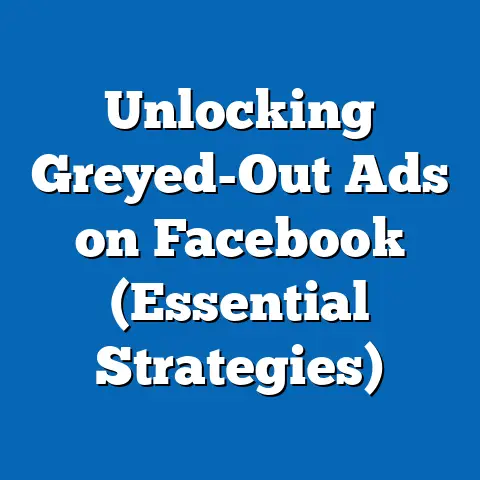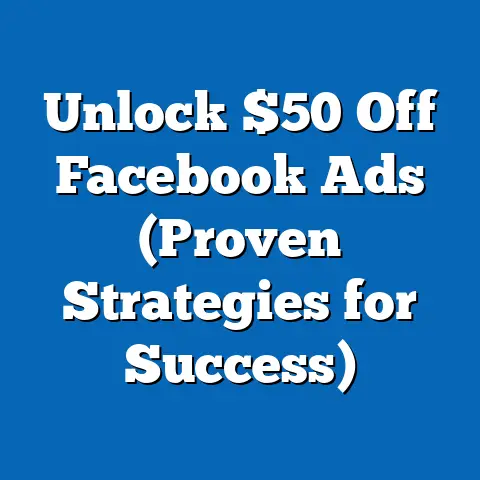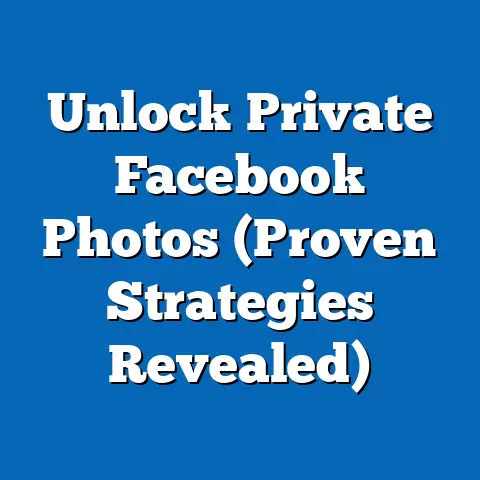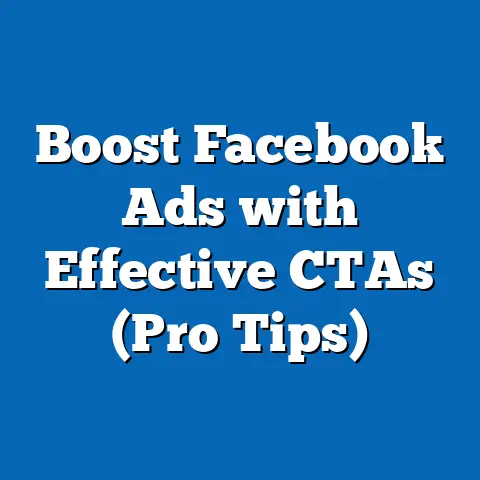Maximize Facebook Ads with WhatsApp Messages (Expert Tips)
In today’s fast-paced world, we’re constantly bombarded with information. We’re living in an era of “smart living,” where technology seamlessly integrates into our daily routines, promising efficiency and convenience. From smart homes to wearable tech, we’re always looking for ways to optimize our lives. This extends to how we interact with brands, too. Gone are the days of passively waiting for information; consumers now demand instant gratification and personalized experiences.
This shift has dramatically changed the landscape of digital marketing. No longer can businesses rely solely on traditional advertising methods. Instead, they need to embrace innovative strategies that foster meaningful connections with their target audience. That’s where Facebook Ads and WhatsApp come in.
Facebook, with its massive reach and sophisticated targeting capabilities, remains a powerhouse in the advertising world. But simply throwing ads into the void isn’t enough. To truly cut through the noise, you need to create a direct line of communication with potential customers. That’s where WhatsApp, the world’s leading messaging app, enters the picture.
I remember when I first started experimenting with combining Facebook Ads and WhatsApp for a small e-commerce client selling handmade jewelry. Before, we were relying solely on website traffic from Facebook Ads, with a conversion rate that was… well, let’s just say it wasn’t something to write home about. We were spending money, driving traffic, but not seeing the sales we hoped for.
Then, we decided to try Click-to-WhatsApp ads. The results were astounding. Suddenly, we were having real-time conversations with potential buyers, answering their questions, addressing their concerns, and building trust. The conversion rate skyrocketed! It was a lightbulb moment for me, and it solidified my belief in the power of combining these two platforms.
Key Takeaways:
- Facebook Ads offer unparalleled reach and targeting capabilities.
- WhatsApp provides a direct and personalized communication channel with customers.
- Combining Facebook Ads and WhatsApp can significantly improve customer engagement and conversion rates.
- This article will provide actionable tips and strategies for effectively integrating these two platforms.
- Embrace the future of “smart living” by leveraging technology to connect with your audience in meaningful ways.
Section 1: Understanding the Power of Facebook Ads and WhatsApp
Let’s dive deeper into why Facebook Ads and WhatsApp are such potent forces in the digital marketing realm, and more importantly, why combining them is a game-changer.
The Enduring Power of Facebook Ads
Despite the rise of newer social media platforms, Facebook remains a dominant force. With billions of active users worldwide, it offers unparalleled reach for businesses looking to connect with their target audience. But it’s not just about the sheer numbers; it’s about the sophisticated targeting capabilities that Facebook Ads provide.
I’ve seen firsthand how precise targeting can transform a campaign. For instance, I worked with a local bakery that wanted to promote their new line of gluten-free products. Instead of simply running a generic ad campaign, we used Facebook’s targeting options to reach users who were interested in gluten-free diets, had liked pages related to health and wellness, and lived within a certain radius of the bakery. The result? A highly engaged audience and a significant increase in sales of their gluten-free products.
Here are some key statistics that highlight Facebook’s advertising success:
- Vast Reach: Facebook boasts billions of monthly active users, making it one of the most widely used social media platforms globally.
- Granular Targeting: Facebook offers extensive targeting options based on demographics, interests, behaviors, and more, allowing advertisers to reach specific audience segments.
- Diverse Ad Formats: Facebook supports various ad formats, including image ads, video ads, carousel ads, and more, providing flexibility for different marketing goals.
- Measurable Results: Facebook’s robust analytics tools enable advertisers to track ad performance, measure ROI, and optimize campaigns for better results.
- Mobile-First Platform: With the majority of users accessing Facebook on mobile devices, the platform is optimized for mobile advertising, ensuring seamless user experiences.
Facebook Ads are more than just a way to get your brand in front of people; they’re a powerful tool for building relationships, driving traffic, and ultimately, increasing sales.
The Rise of WhatsApp as a Communication Platform
WhatsApp has evolved from a simple messaging app into a vital communication tool for businesses. Its massive user base, high engagement rates, and direct messaging capabilities make it an ideal platform for fostering customer relationships and driving conversions.
Think about your own experience with WhatsApp. You probably use it to communicate with friends and family, share updates, and stay connected. That same level of intimacy and convenience can be leveraged by businesses to create a more personal and engaging experience for their customers.
I remember a conversation I had with a restaurant owner who started using WhatsApp to take orders and confirm reservations. He told me that it completely transformed his business. Customers loved the convenience of being able to place orders directly through WhatsApp, and he was able to provide faster and more personalized service.
Here’s why WhatsApp is so effective as a marketing channel:
- Global Reach: WhatsApp has billions of users worldwide, making it a global communication platform for businesses of all sizes.
- Direct Messaging: WhatsApp allows businesses to send direct messages to customers, providing personalized communication and support.
- High Engagement Rates: WhatsApp messages have high open and response rates compared to traditional marketing channels like email.
- Multimedia Support: WhatsApp supports various multimedia formats, including images, videos, and voice messages, allowing businesses to create engaging and interactive content.
- Business Tools: WhatsApp Business offers features like automated messages, quick replies, and business profiles, making it easier for businesses to manage customer interactions.
The Synergy of Facebook Ads and WhatsApp
Combining Facebook Ads with WhatsApp creates a powerful synergy that amplifies the strengths of both platforms. Facebook Ads drive targeted traffic to WhatsApp, where businesses can engage in personalized conversations, build trust, and ultimately, convert leads into customers.
Here’s how it works:
- Targeted Ads: Use Facebook’s advanced targeting options to reach your ideal customers based on demographics, interests, behaviors, and more.
- Click-to-WhatsApp Ads: Create ads that direct users to WhatsApp with a single click, making it easy for them to start a conversation with your business.
- Personalized Conversations: Engage in personalized conversations with potential customers, answer their questions, address their concerns, and build trust.
- Drive Conversions: Use WhatsApp to guide customers through the sales process, offer exclusive deals, and ultimately, convert leads into paying customers.
I’ve seen this strategy work wonders for businesses in various industries. From e-commerce stores to local service providers, the ability to have real-time conversations with potential customers is a game-changer.
Key Takeaways:
- Facebook Ads offer unparalleled reach and targeting capabilities.
- WhatsApp provides a direct and personalized communication channel with customers.
- Combining Facebook Ads and WhatsApp amplifies the strengths of both platforms.
- This synergy leads to improved customer interactions, faster response times, and higher conversion rates.
- By understanding the power of Facebook Ads and WhatsApp, businesses can unlock new opportunities for growth and success.
Next Steps:
- Explore Facebook’s advertising options and identify your target audience.
- Set up a WhatsApp Business account to start engaging with customers directly.
- Consider how you can integrate Facebook Ads and WhatsApp to create a more personal and engaging experience for your audience.
Section 2: Setting Up Your Facebook Ads for WhatsApp Integration
Now that we’ve established the “why,” let’s move on to the “how.” Setting up your Facebook Ads for WhatsApp integration is a straightforward process, but it’s important to get it right to ensure a seamless experience for your customers.
Setting Up Your WhatsApp Business Account
Before you can start running Click-to-WhatsApp ads, you’ll need a WhatsApp Business account. This is a free account that provides additional features specifically designed for businesses, such as:
- Business Profile: Create a profile with your business name, description, contact information, website, and hours of operation.
- Automated Messages: Set up automated welcome messages and away messages to greet customers and manage expectations.
- Quick Replies: Save frequently used responses to common questions to save time and provide faster service.
- Labels: Organize your chats with labels to easily identify and track customer interactions.
- Catalog: Showcase your products and services with a catalog that customers can browse directly within WhatsApp.
Setting up a WhatsApp Business account is easy. Simply download the WhatsApp Business app from the App Store or Google Play Store and follow the instructions.
Linking WhatsApp to Your Facebook Page
Once you have a WhatsApp Business account, you’ll need to link it to your Facebook Page. This allows you to run Click-to-WhatsApp ads and manage your WhatsApp messages directly from your Facebook Page.
Here’s how to link your WhatsApp Business account to your Facebook Page:
- Go to your Facebook Page settings.
- Click on “WhatsApp” in the left-hand menu.
- Click on “Connect WhatsApp Account.”
- Enter your WhatsApp Business phone number and follow the instructions to verify your account.
Once your WhatsApp Business account is linked to your Facebook Page, you’re ready to start creating Click-to-WhatsApp ads.
Creating Click-to-WhatsApp Ads
Click-to-WhatsApp ads are a type of Facebook Ad that includes a button that directs users to WhatsApp with a single click. This makes it incredibly easy for potential customers to start a conversation with your business.
Here’s how to create a Click-to-WhatsApp ad:
- Go to Facebook Ads Manager.
- Create a new campaign and choose the “Traffic” or “Messages” objective.
- Select your target audience, budget, and schedule.
- Choose “WhatsApp” as the destination for your ad.
- Create your ad copy and visuals.
- Add a call-to-action button that encourages users to message you on WhatsApp (e.g., “Send Message,” “Chat on WhatsApp,” “Learn More”).
- Review and publish your ad.
When creating your ad copy and visuals, it’s important to highlight the benefits of messaging you on WhatsApp. For example, you could mention that customers can get instant answers to their questions, receive personalized recommendations, or access exclusive deals.
Ad Formats for WhatsApp Messaging
Facebook offers several ad formats that can be used to encourage WhatsApp messaging. Here are some of the most popular options:
- Image Ads: Simple and effective, image ads can be used to showcase your products or services and encourage users to message you on WhatsApp for more information.
- Video Ads: Video ads are a great way to capture attention and tell a story. Use video to demonstrate your product, share customer testimonials, or offer exclusive content.
- Carousel Ads: Carousel ads allow you to showcase multiple products or services in a single ad. This is a great option for e-commerce businesses looking to drive traffic to their WhatsApp store.
- Collection Ads: Collection ads are designed for mobile shopping and allow users to browse and purchase products directly from your ad. This is a great option for businesses with a large product catalog.
The best ad format for your business will depend on your specific goals and target audience. Experiment with different ad formats to see what works best for you.
Crafting Compelling Ad Copy and Visuals
Your ad copy and visuals are crucial for capturing attention and encouraging users to click through to WhatsApp. Here are some tips for creating compelling ads:
- Highlight the Benefits: Focus on the benefits of messaging you on WhatsApp. What can customers expect to gain by starting a conversation with your business?
- Use Strong Calls-to-Action: Use clear and concise calls-to-action that encourage users to message you on WhatsApp. Examples include “Send Message,” “Chat on WhatsApp,” “Learn More,” and “Get a Quote.”
- Use High-Quality Visuals: Use high-quality images or videos that are visually appealing and relevant to your target audience.
- Keep it Concise: Keep your ad copy concise and to the point. Focus on the most important information and avoid overwhelming users with too much text.
- Test Different Variations: Test different variations of your ad copy and visuals to see what resonates best with your target audience.
I’ve found that using questions in your ad copy can be particularly effective. For example, “Have a question about our new product? Message us on WhatsApp for instant answers!” This encourages users to engage with your business and start a conversation.
Key Takeaways:
- Setting up a WhatsApp Business account is essential for running Click-to-WhatsApp ads.
- Linking your WhatsApp Business account to your Facebook Page allows you to manage your messages directly from Facebook.
- Click-to-WhatsApp ads are a type of Facebook Ad that includes a button that directs users to WhatsApp with a single click.
- Facebook offers several ad formats that can be used to encourage WhatsApp messaging.
- Compelling ad copy and visuals are crucial for capturing attention and encouraging users to click through to WhatsApp.
Next Steps:
- Set up a WhatsApp Business account if you don’t already have one.
- Link your WhatsApp Business account to your Facebook Page.
- Create a Click-to-WhatsApp ad and experiment with different ad formats and messaging.
- Monitor your ad performance and make adjustments as needed to optimize your results.
Section 3: Crafting Effective WhatsApp Messages
Now that you’ve set up your Facebook Ads and are driving traffic to WhatsApp, the next step is to craft effective messages that resonate with your target audience and drive conversions. Remember, the goal is to build relationships, provide value, and guide customers through the sales process.
Personalization Techniques
Personalization is key to making your WhatsApp messages feel more engaging and relevant. Generic, impersonal messages are likely to be ignored, while personalized messages can create a stronger connection with your audience.
Here are some personalization techniques you can use:
- Use the Customer’s Name: Address customers by their first name whenever possible. This simple touch can make a big difference in how they perceive your message.
- Reference Previous Interactions: If you’ve interacted with a customer before, reference that interaction in your message. For example, “Thanks for your interest in our new product! Do you have any questions?”
- Tailor Messages to Specific Interests: Segment your audience based on their interests and tailor your messages accordingly. For example, send different messages to customers who are interested in different products or services.
- Offer Personalized Recommendations: Based on their past purchases or browsing history, offer personalized product or service recommendations.
I once worked with a clothing retailer that used WhatsApp to send personalized style recommendations to their customers. They would ask customers about their preferences, style, and upcoming events, and then send them curated outfits based on their responses. This personalized approach resulted in a significant increase in sales and customer loyalty.
Clear Calls-to-Action (CTAs)
Your WhatsApp messages should always include clear calls-to-action (CTAs) that tell customers what you want them to do next. Without a clear CTA, customers may not know what to do or how to proceed.
Here are some examples of effective CTAs:
- “Learn More”: Direct customers to a landing page or product page for more information.
- “Get a Quote”: Encourage customers to request a quote for your services.
- “Book a Consultation”: Invite customers to book a free consultation with you.
- “Shop Now”: Direct customers to your online store to make a purchase.
- “Claim Your Discount”: Offer customers an exclusive discount or promotion.
Make sure your CTAs are clear, concise, and action-oriented. Use strong verbs and create a sense of urgency to encourage customers to take action.
Using Multimedia to Enhance Messaging
WhatsApp supports various multimedia formats, including images, videos, and voice messages. Using multimedia can enhance your messaging and make it more engaging and interactive.
Here are some ways you can use multimedia in your WhatsApp messages:
- Showcase Your Products: Use images and videos to showcase your products and demonstrate their features and benefits.
- Share Customer Testimonials: Share video testimonials from satisfied customers to build trust and credibility.
- Provide Tutorials and Demonstrations: Use video to provide tutorials and demonstrations on how to use your products or services.
- Offer Exclusive Content: Offer exclusive content, such as behind-the-scenes footage or sneak peeks, to reward your loyal customers.
- Personalize Your Messages: Use voice messages to add a personal touch to your messages and build rapport with your audience.
I’ve found that using short, engaging videos can be particularly effective in WhatsApp messages. People are more likely to watch a short video than read a long text message.
Timing and Frequency of Messages
The timing and frequency of your WhatsApp messages are crucial. Sending too many messages can overwhelm customers and lead them to unsubscribe, while sending too few messages can cause them to forget about you.
Here are some best practices for timing and frequency of messages:
- Respect Time Zones: Consider your customers’ time zones when sending messages. Avoid sending messages late at night or early in the morning.
- Don’t Overwhelm Customers: Avoid sending too many messages in a short period of time. Space out your messages to avoid overwhelming customers.
- Provide Value with Every Message: Make sure every message you send provides value to your customers. Avoid sending irrelevant or promotional messages.
- Ask for Feedback: Ask customers for feedback on your messaging to see what they like and dislike.
- Use Segmentation: Segment your audience and send different messages to different groups based on their interests and preferences.
I recommend starting with a moderate frequency and then adjusting based on customer feedback and engagement rates.
Key Takeaways:
- Personalization is key to making your WhatsApp messages feel more engaging and relevant.
- Your WhatsApp messages should always include clear calls-to-action (CTAs) that tell customers what you want them to do next.
- Using multimedia can enhance your messaging and make it more engaging and interactive.
- The timing and frequency of your WhatsApp messages are crucial.
- By following these best practices, you can craft effective WhatsApp messages that resonate with your target audience and drive conversions.
Next Steps:
- Start personalizing your WhatsApp messages by using customer names and referencing previous interactions.
- Include clear calls-to-action (CTAs) in every message.
- Experiment with using multimedia to enhance your messaging.
- Pay attention to the timing and frequency of your messages and adjust as needed.
- Ask for feedback from your customers to see what they like and dislike about your messaging.
Section 4: Leveraging Customer Data and Insights
Data is the lifeblood of any successful marketing campaign, and Facebook Ads and WhatsApp are no exception. By tracking and analyzing your ad performance and customer interactions, you can gain valuable insights that will help you refine your strategies and achieve better results.
Using Facebook’s Analytics Tools
Facebook’s analytics tools provide a wealth of information about your ad performance, including:
- Reach: The number of people who saw your ad.
- Impressions: The number of times your ad was displayed.
- Clicks: The number of times people clicked on your ad.
- Click-Through Rate (CTR): The percentage of people who clicked on your ad after seeing it.
- Cost Per Click (CPC): The average cost you paid for each click on your ad.
- Conversions: The number of people who took a desired action after clicking on your ad (e.g., made a purchase, submitted a lead form).
- Cost Per Conversion (CPC): The average cost you paid for each conversion.
By tracking these metrics, you can identify which ads are performing well and which ones are not. You can then use this information to optimize your campaigns for better results.
For example, if you notice that your CTR is low, you may need to revise your ad copy or visuals to make them more appealing. If your CPC is high, you may need to adjust your targeting or bidding strategy.
Tracking and Analyzing WhatsApp Engagement Metrics
In addition to Facebook’s analytics tools, you should also track and analyze your WhatsApp engagement metrics. These metrics can provide valuable insights into how customers are interacting with your business on WhatsApp.
Here are some key WhatsApp engagement metrics to track:
- Response Rate: The percentage of messages that you respond to.
- Average Response Time: The average time it takes you to respond to a message.
- Conversation Length: The average length of your conversations with customers.
- Conversion Rate: The percentage of conversations that result in a sale or other desired outcome.
- Customer Satisfaction: How satisfied customers are with your WhatsApp interactions.
By tracking these metrics, you can identify areas where you can improve your WhatsApp messaging and customer service.
For example, if your response rate is low, you may need to assign more staff to manage your WhatsApp messages. If your average response time is slow, you may need to implement automated responses or quick replies. If your conversion rate is low, you may need to refine your messaging or offer more incentives to customers.
Utilizing Data to Refine Future Ad Campaigns and Messaging Strategies
The data you gather from Facebook’s analytics tools and WhatsApp engagement metrics can be used to refine your future ad campaigns and messaging strategies.
Here are some ways you can utilize this data:
- Identify Your Best Performing Ads: Use Facebook’s analytics tools to identify your best performing ads. Analyze these ads to see what made them successful and replicate those elements in your future campaigns.
- Optimize Your Targeting: Use Facebook’s targeting options to refine your audience and reach the most qualified leads.
- Personalize Your Messaging: Use customer data to personalize your WhatsApp messages and make them more relevant to your audience.
- A/B Test Your Messages: A/B test different variations of your WhatsApp messages to see what resonates best with your audience.
- Segment Your Audience: Segment your audience based on their interests and preferences and send them different messages accordingly.
I remember working with a client who was struggling to generate leads through their Facebook Ads. After analyzing their data, we discovered that their ads were performing well with a specific demographic group. We then refined their targeting to focus on that demographic group, and their lead generation skyrocketed.
Key Takeaways:
- Data is the lifeblood of any successful marketing campaign.
- Facebook’s analytics tools provide a wealth of information about your ad performance.
- Tracking and analyzing WhatsApp engagement metrics can provide valuable insights into how customers are interacting with your business on WhatsApp.
- The data you gather can be used to refine your future ad campaigns and messaging strategies.
- By leveraging customer data and insights, you can optimize your marketing efforts and achieve better results.
Next Steps:
- Start tracking your Facebook ad performance using Facebook’s analytics tools.
- Track your WhatsApp engagement metrics, such as response rate, average response time, and conversion rate.
- Analyze your data to identify areas where you can improve your marketing efforts.
- Use your data to refine your future ad campaigns and messaging strategies.
Section 5: Case Studies and Success Stories
To illustrate the power of combining Facebook Ads and WhatsApp, let’s take a look at some real-world case studies and success stories. These examples will showcase the strategies that successful businesses have used to achieve their goals and the results they have achieved.
Case Study 1: E-commerce Store Increases Sales by 30%
An e-commerce store selling handmade jewelry was struggling to generate sales through their traditional advertising methods. They decided to try combining Facebook Ads and WhatsApp to create a more personal and engaging experience for their customers.
They created Click-to-WhatsApp ads that directed users to WhatsApp with a single click. When customers messaged them on WhatsApp, they would provide personalized recommendations, answer their questions, and offer exclusive discounts.
The results were astounding. The e-commerce store saw a 30% increase in sales and a significant improvement in customer satisfaction. Customers loved the convenience of being able to chat with the store directly and receive personalized recommendations.
Case Study 2: Local Service Provider Generates More Leads
A local service provider offering home cleaning services was looking for a way to generate more leads. They decided to try using Facebook Ads to drive traffic to their WhatsApp account.
They created ads that targeted users who were interested in home cleaning services and lived within a certain radius of their business. When users clicked on their ads, they were directed to WhatsApp, where they could request a quote or book a consultation.
The local service provider saw a significant increase in leads and bookings. Customers appreciated the ability to get quick answers to their questions and schedule appointments directly through WhatsApp.
Case Study 3: Restaurant Improves Customer Service and Order Efficiency
A restaurant owner wanted to improve customer service and order efficiency. He decided to use WhatsApp to take orders and confirm reservations.
He created a WhatsApp Business account and promoted it on his Facebook Page. Customers could then message him on WhatsApp to place orders or make reservations.
The restaurant owner saw a significant improvement in customer service and order efficiency. Customers loved the convenience of being able to place orders directly through WhatsApp, and he was able to provide faster and more personalized service.
Quotes and Testimonials
To add credibility to these success stories, let’s hear from some business owners and marketing experts:
- “Combining Facebook Ads and WhatsApp has been a game-changer for our business. We’ve seen a significant increase in sales and customer satisfaction.” – E-commerce Store Owner
- “WhatsApp has allowed us to connect with our customers on a more personal level and provide them with the support they need.” – Local Service Provider
- “Using WhatsApp to take orders and confirm reservations has streamlined our operations and improved customer service.” – Restaurant Owner
- “Facebook Ads and WhatsApp are a powerful combination for businesses looking to drive conversions and build relationships.” – Marketing Expert
Key Takeaways:
- Combining Facebook Ads and WhatsApp can lead to significant improvements in sales, lead generation, and customer service.
- Successful businesses have used this strategy to achieve their goals and build stronger relationships with their customers.
- By learning from these case studies and success stories, you can implement similar strategies in your own business.
Next Steps:
- Review these case studies and success stories and identify strategies that you can implement in your own business.
- Consider how you can use Facebook Ads and WhatsApp to achieve your specific goals.
- Start experimenting with different strategies and track your results to see what works best for you.
Section 6: The Future of Facebook Ads and Messaging Apps
The world of digital marketing is constantly evolving, and it’s important to stay ahead of the curve to remain competitive. Let’s take a look at some emerging trends in social media advertising and messaging and speculate on the potential future developments in the integration of Facebook Ads and messaging platforms like WhatsApp.
Emerging Trends in Social Media Advertising and Messaging
Here are some emerging trends that are shaping the future of social media advertising and messaging:
- AI-Powered Chatbots: AI-powered chatbots are becoming increasingly sophisticated and are able to handle a wide range of customer inquiries. They can provide instant answers to questions, offer personalized recommendations, and even process orders.
- Personalized Experiences: Customers are demanding more personalized experiences from brands. They want to be treated as individuals and receive messages that are relevant to their interests and preferences.
- Video Marketing: Video marketing is becoming increasingly popular as a way to capture attention and engage with audiences. Short, engaging videos are particularly effective on social media and messaging platforms.
- Augmented Reality (AR): Augmented reality (AR) is being used to create immersive and interactive experiences for customers. For example, customers can use AR to try on clothes virtually or see what furniture would look like in their home.
- Social Commerce: Social commerce is the practice of selling products and services directly through social media platforms. This allows customers to make purchases without leaving the platform.
I believe that AI-powered chatbots will play an increasingly important role in the future of Facebook Ads and WhatsApp. They can automate many of the tasks that are currently handled by human agents, such as answering questions and providing support. This will free up human agents to focus on more complex and strategic tasks.
Potential Future Developments
Here are some potential future developments in the integration of Facebook Ads and messaging platforms like WhatsApp:
- More Seamless Integration: Facebook may make it even easier for businesses to integrate their Facebook Ads with WhatsApp. This could include features such as automated messaging, personalized recommendations, and social commerce.
- Advanced Targeting Options: Facebook may introduce more advanced targeting options that allow businesses to reach customers based on their WhatsApp activity.
- Improved Analytics: Facebook may improve its analytics tools to provide businesses with more detailed insights into their WhatsApp performance.
- New Ad Formats: Facebook may introduce new ad formats that are specifically designed for WhatsApp.
- Enhanced AI Capabilities: AI-powered chatbots may become even more sophisticated and be able to handle a wider range of customer inquiries.
I envision a future where Facebook Ads and WhatsApp are seamlessly integrated, allowing businesses to create truly personalized and engaging experiences for their customers.
Staying Ahead of the Curve
To stay ahead of the curve, it’s important to:
- Stay Informed: Keep up-to-date on the latest trends and developments in social media advertising and messaging.
- Experiment: Experiment with new strategies and technologies to see what works best for your business.
- Analyze Your Data: Track and analyze your data to identify areas where you can improve your marketing efforts.
- Adapt: Be prepared to adapt your marketing strategies as the landscape changes.
- Embrace Innovation: Embrace innovation and be willing to try new things.
Key Takeaways:
- The world of digital marketing is constantly evolving.
- Emerging trends in social media advertising and messaging include AI-powered chatbots, personalized experiences, video marketing, augmented reality (AR), and social commerce.
- Potential future developments in the integration of Facebook Ads and messaging platforms like WhatsApp include more seamless integration, advanced targeting options, improved analytics, new ad formats, and enhanced AI capabilities.
- To stay ahead of the curve, it’s important to stay informed, experiment, analyze your data, adapt, and embrace innovation.
Next Steps:
- Research the emerging trends in social media advertising and messaging.
- Identify technologies and strategies that you can implement in your own business.
- Start experimenting with new strategies and track your results.
- Be prepared to adapt your marketing strategies as the landscape changes.
Conclusion
In this article, we’ve explored the power of combining Facebook Ads and WhatsApp messaging for effective marketing. We’ve discussed how to set up your ads, craft compelling messages, leverage customer data, and even shared real-world success stories.
I hope that this guide has provided you with the knowledge and tools you need to unlock the full potential of Facebook Ads and WhatsApp for your business. Remember, the key to success is to create a personal and engaging experience for your customers. By following the tips and strategies outlined in this article, you can build stronger relationships with your audience, drive conversions, and achieve your marketing goals.
Now, it’s time to take action. Start implementing these strategies in your own business and see the results for yourself. Don’t be afraid to experiment and try new things. The world of digital marketing is constantly evolving, so it’s important to stay informed and adapt your strategies as needed.
I encourage you to share your experiences or ask questions about using WhatsApp with Facebook Ads. Let’s learn from each other and build a community of successful marketers.
Thank you for reading!

